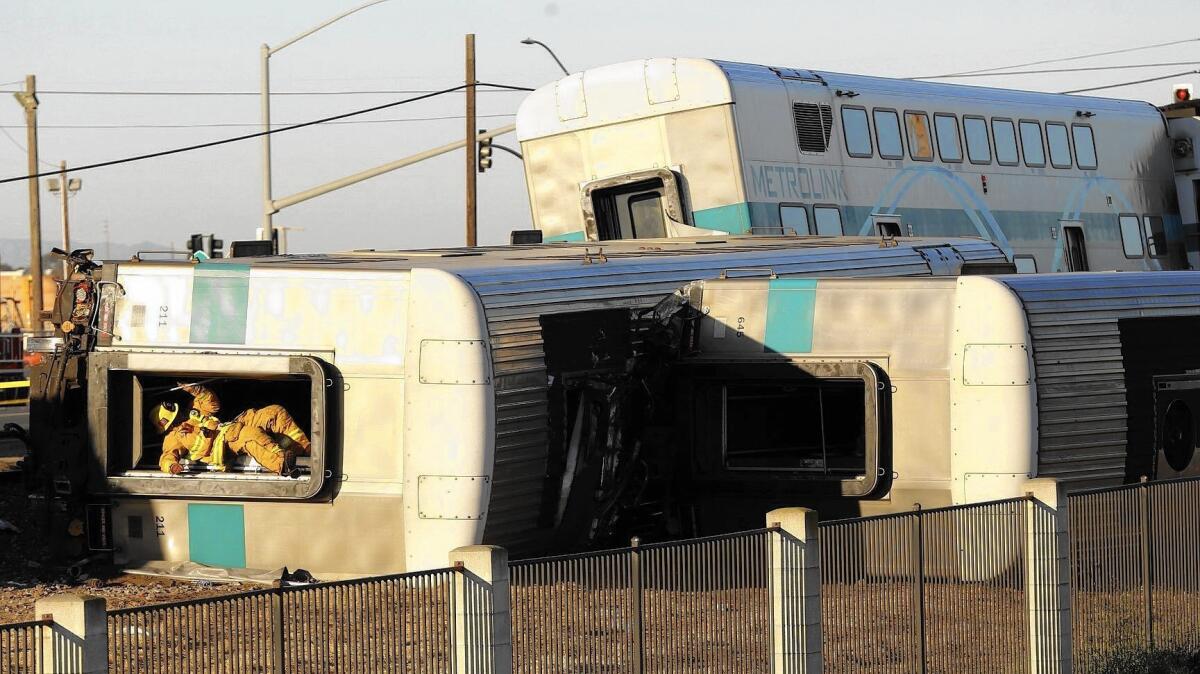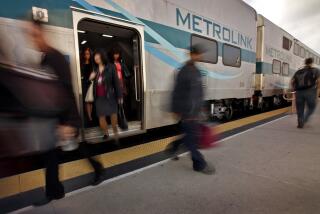New Metrolink cars’ safety features probably reduced casualties

- Share via
Metrolink’s investment of hundreds of millions of dollars in safety improvements after a series of deadly collisions probably reduced casualties in Tuesday’s Oxnard crash, but the accident also highlighted the limits of the ongoing campaign.
Three crash-resistant cars in Metrolink’s new $263-million fleet of state-of-the-art passenger coaches performed well in their first test involving a major crash, rail officials said.
Metrolink train crash: Pickup driver had previous DUI conviction
Although 28 passengers and crew members were injured when the L.A.-bound morning train struck a pickup and trailer near Oxnard, authorities emphasized there were no fatalities and the relatively heavy, energy-absorbing cars remained intact.
The cars, among the first to incorporate years of accident research, have front and rear crush zones, tables that give way in a wreck, improved emergency exits, fire retardant materials and more protective seating designs.
“We’ve spent a bundle on safety,” said Richard Katz, a former state legislator and longtime Metrolink board member. “Accidents happen. When they do, we want to make sure our passengers and crews are in the safest cars and safest situations we can create.”
However, experts noted that the new cars came off the tracks, despite anti-derailing devices, and that the collision was Metrolink’s fourth serious accident involving a train pushed by a locomotive.
Get essential California coverage
That widespread practice has been questioned in safety studies and lawsuits, in part because lighter, more vulnerable passenger cars, with an engineer’s station, are placed at the front of speeding trains. Late Tuesday, the Metrolink engineer at the controls before the crash was among the most seriously injured and remained in an intensive care unit.
The crash also underscored a key shortcoming of a $210-million, high-tech collision avoidance system Metrolink is testing on part of its 512-mile network.
The sophisticated system can prevent train collisions such as Metrolink’s 2008 head-on wreck in Chatsworth. But it would not have been able to detect the vehicle that was on the rails Tuesday near Oxnard, after the driver turned onto the tracks and drove about 80 feet west of the grade crossing.
Beyond technology, the location of the crash once again spotlighted a massive, costly backlog of overpass projects intended to separate rail and street traffic. The crossing near 5th Street and Rice Avenue, on a straight stretch of track where trains travel at top speeds, has a history of deadly accidents and is ranked among the two dozen most dangerous in California.
Officials said a $30-million grade separation planned for the intersection has languished awaiting state and federal funding.
The crossing is “one of thousands in Southern California, and many of them need attention,” said Moorpark Mayor Pro Tem Keith Millhouse, a Metrolink board member.
National Transportation Safety Board investigators arrived at the crash scene late Tuesday, spurred in part by the “unusual” circumstances surrounding the collision, said board member Robert Sumwalt.
“We don’t go to every grade crossing incident, but we are very interested in this for a number of factors,” he said.
By Tuesday night, investigators had already collected ample data, including footage from both inward- and outward-facing cameras that were installed in the wake of the deadly Chatsworth collision.
The train’s event data recorder was also recovered, and officials said it will give information on the train’s speed and use of horns. The agency’s experts, along with officials from the Federal Railroad Administration, will analyze the behavior of the truck driver and his truck, safety features at the rail crossing, as well as performance of the rail cars and train crew.
The accident occurred after the driver of the pickup, identified as Jose Alejandro Sanchez-Ramirez, drove onto the rails and traveled about 80 feet west of the grade crossing toward Oxnard.
He was found about a mile and a half from the crash site, wandering and looking disoriented. He has been arrested on suspicion of felony hit and run, Oxnard Assistant Police Chief Jason Benites said.
The Metrolink engineer spotted the truck seconds before the pre-sunrise collision and began an emergency stop, but it was too late. The impact demolished the vehicle and derailed all four passenger cars of the train.
The lead passenger car was spun almost 180 degrees, and several others became uncoupled as they toppled over on their sides.
Railroad officials said the accident could have been much worse had Metrolink not largely replaced its older, lighter rolling stock with 137 of the new South Korean-manufactured Rotem rail cars.
The safety features of the vehicles marked a milestone in Metrolink’s effort to regain public trust after a 2005 Glendale crash that killed 11 people and the Chatsworth collision that left 25 dead and 135 injured.
“We’ve spent several hundred million dollars on the best technology available,” said Orange County Supervisor Shawn Nelson, chairman of the Metrolink board. “The cars seem to have done what they were supposed to do. We bought the right piece of equipment.”
Nelson and other Metrolink board members defended the practice of pushing passenger cars.
Since 1992, 15 passengers have been killed in three other accidents involving Metrolink trains in the push mode. They occurred in Placentia, Burbank and Glendale — an accident that focused national attention on the practice used by passenger railroads across the country.
In push mode, trains are controlled from the front via so-called cab cars, which are filled with passenger seating and have an engineer’s station.
A new, heavier Rotem cab car, equipped with a protective crushable nose cone, was leading the train when it hit the truck Tuesday.
Some safety experts say putting heavier locomotives at the back of trains leaves passengers more vulnerable in frontal crashes and can be risky along routes in dense urban settings with many grade crossings.
“The mass of a cab car, even if beefed up, is not the same as a locomotive,” said William Keppen, a railroad safety expert in Baltimore. “You just don’t get the same level of protection, and the number of cars that were to derail would probably be fewer.”
Millhouse said the NTSB will determine what role, if any, the push mode played in the crash and subsequent derailment.
“If a locomotive had been in front, there could have been a fire from leaking fuel from the impact,” he said. “I don’t think pushing the train had anything to do with it, but that is just speculation.”
But Ed Pfiester Jr., a Los Angeles attorney who has handled lawsuits related to the Placentia and Chatsworth crashes, contended that had an engine been in front during the Oxnard crash, it would have simply knocked the pickup and trailer out of the way.
“There are a lot of grade crossings in the area,” Pfiester said. “Every one of them is a potential disaster for pushed Metrolink trains.”
Across Metrolink’s six-county system, there are 818 rail crossings, including 451 at street level. About two-thirds are controlled by Metrolink and the rest by two freight operators, Union Pacific and the Burlington Northern Santa Fe Railway.
Among the most dangerous is the Rice Avenue crossing where Tuesday’s crash occurred. Officials noted it is ranked the 23rd worst in the state in terms of safety.
Also, according to a Times analysis completed in 2009, at least seven accidents resulting in one death and two injuries occurred in the previous 16 years along a seven-mile straightaway that includes the Rice Avenue crossing. The latest federal accident reports show that the Rice Avenue crossing was the scene of additional accidents in 2009, 2010 and last June. Two people died in the latter collision between a vehicle and a train.
More to Read
Sign up for Essential California
The most important California stories and recommendations in your inbox every morning.
You may occasionally receive promotional content from the Los Angeles Times.












